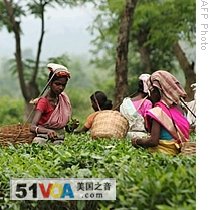New Delhi
22 June 2009
In India, stalled monsoon rains are expected to revive soon. But there are concerns the shortfall in monsoon rains so far could adversely impact crop production.
 |
| Indian women harvest tea leaves at a plantation in Kondoli, some 17 km from Nagaon in the northeastern state of Assam, 19 June 2009 |
The monsoon rains arrived at the end of May as scheduled, but then slowed down. The weather department says rainfall in the first three weeks of June was 45 percent below normal.
The dry spell in June has worried millions of farmers in the country waiting to sow crops such as rice, and raised fears that food production, which is critically dependent on copious monsoon rains, could suffer this year.
Agriculture expert, Devender Sharma, says concerns about the deficient rains are running high in those parts of the country that have no access to modern irrigation systems.
"The most important areas which will face the crisis would be of course the dryland regions of India, which produces about 45 percent of total food requirement of the country," said Sharma. "Most of these are of course the crops which anything can go wrong, a few weeks or four weeks of delay of rainfall would mean a complete debacle."
Sharma says the next two weeks could be critical in determining whether the production of such crops as rice, oilseeds, cotton and corn will be impacted adversely.
The federal government says it is preparing to provide drought resistant varieties of seeds to regions that are dependent on the monsoons. And it has convened a meeting later in the week of farm officials from states that could be hit hard such as Uttar Pradesh, Orissa, Maharashtra and Andhra Pradesh.
The government monitors food grain production carefully to ensure that there is enough to meet the requirements of its one billion people. India is the world's second highest producer of rice and wheat.
Agriculture plays a crucial part in the Indian economy sustaining the livelihoods of nearly two-thirds of the country, or 600 million people. Although the farm sector contributes only 20 percent to the country's gross domestic product, good rains ensure higher incomes in the vast rural areas, and fuel demand for domestic products ranging from mobile phones to tractors.
The monsoons may also be crucial in ensuring the Indian economy, which is showing signs of emerging from the global recession, stays on the path of revival.